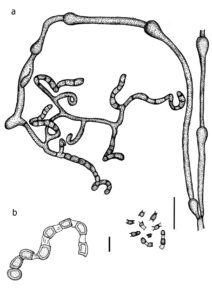Fungalpedia – Note 244, Malbranchea
Malbranchea Sacc.
Citation when using this entry: Thakshila et al. 2024 (in prep) – Fungalpedia, Onygenales, Eurotiales, and Verrucariales.
Index Fungorum, Facesoffungi, MycoBank, GenBank, Fig. 1
Classification: Onygenaceae, Onygenales, Eurotiomycetidae, Eurotiomycetes, Fungi
Malbranchea was introduced as a family by Saccardo (1882) which was isolated on wet-cardboard in Rouen, France. This genus is typified by Malbranchea pulchella, and naturally occurs as a saprophyte on decaying plant materials or as a parasitic organism in animals (Cooney & Emerson 1964). Only an asexual state has been reported. Benda & Corey (1994) and Cooney & Emerson (1964) reported three cases of sinonasal M. pulchella infections in humans. Malbranchea is characterized by branched hyphae with prominent swelling near the septations. Fertile hyphal tips progressively and regularly septate toward the base. Curved fertile branch tips consist of thick-walled arthroconidia and thin-walled isthmus. After breaking off the connecting isthmuses, the conidia separate, are pale yellow or hyaline, and alternate in shape (Cooney & Emerson 1964). Auxarthron is synonymized under Malbranchea based on ITS and LSU sequences (Rodríguez-Andrade et al. 2021).
Type species: Malbranchea pulchella Sacc. & Penz
Other accepted species: (Species Fungorum – search Malbranchea)
Figure 1 – Malbranchea pulchella a Branched fertile hypha b Holoarthric conidia. Scale bar: a = 20 μm, b = 5 μm. Redrawn from Benda and Corey (1994).
References
Saccardo PA. 1882 – Fungi Gallici. Series IV. Michelia 2,583–648.
Entry by
Subasingha A. D. Thakshila, Center of Excellence in Fungal Research, School of Science, Mae Fah Luang University, Chiang Rai 57100, Thailand
(Edited by Chitrabhanu S. Bhunjun, Kevin D. Hyde, Samaneh Chaharmiri-Dokhaharani, & Achala R. Rathnayaka)
Published online 22 April 2024
